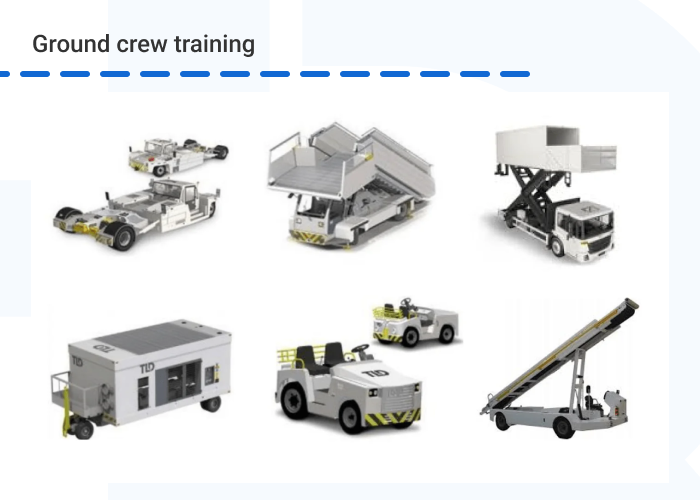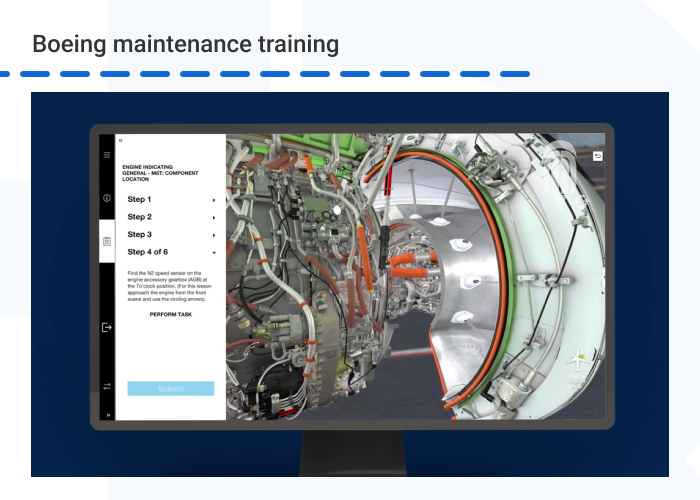VR in Aircraft Maintenance Training
Benefits of VR-powered Aviation Maintenance and Engineering (AME) Training
VR Training Applications in Aircraft Maintenance
While aircraft maintenance over the lifetime of each plane plays a crucial role in air travel safety, the industry faces a shortage of qualified technicians. This skills gap stems in part from the high costs and complexity of traditional hands-on training methods, often limiting opportunities for aspiring mechanics.
A U.S. Bureau of Labor Statistics report says the aviation sector will need to hire 12,000 new aircraft mechanics annually to meet demand. However, the number of trainees graduating from maintenance programs has dropped 30% year-over-year.
This is where Virtual reality (VR) solutions come into play, by offering an alternative for experiencing realistic scenarios safely. Blending theory and practice, maintenance training in Virtual Reality enables unlimited, location-independent practice while simulating real-world conditions. It’s like stepping into a video game, but with a sense of real presence in the action.
This article will explore how VR creates a more effective learning framework for aspiring aircraft mechanics.
VR in Aircraft Maintenance Training
Benefits of VR-powered Aviation Maintenance and Engineering (AME) Training
VR Training Applications in Aircraft Maintenance
Extensive studies have shown VR to be an effective solution for mitigating the risks inherent in traditional aircraft mechanic training methods. In fact, a recent market analysis found adoption of Virtual and Augmented Reality technologies by the aviation industry has grown markedly. Spending in this area reached an estimated $1.76 billion in 2023 and is projected to surge over tenfold to $17.86 billion by 2030.
By generating immersive virtual scenarios that closely mirror real-world conditions, trainees can explore interactive 3D re-creations of full-scale aircraft systems and workspaces through VR headsets. As a result, mechanics-in-training bolster their competencies in inspecting components, conducting repairs, and resolving technical issues before working on physical aircraft.
Researchers say VR provides numerous advantages for complex maintenance training. For instance, VR can accelerate the learning process up to 4 times by providing trainees more free-risk opportunities for practice.
So, what other valuable benefits does VR bring to the table?
Want to create a VR training? We’re ready to help!HQSoftware has a team of skilled professionals ready to tackle the project. Ask me!
Anna Halias
Business Development Manager
In many ways, VR training goes beyond the mechanics of skills-building to address systemic challenges in aviation technical education, including:
As the benefits to using VR are clear, let’s take a look at some real-world applications for VR in this critical field of training.
How do modern businesses use AR to increase their revenues and outperform their industry competitors?

A virtual environment allows for more flexible learning, offering extensive control over training scenarios based on skill levels. Here are the three main applications of VR in aircraft maintenance:
First, VR allows engineers and mechanics in training to freely explore interactive 3D models of diverse aircraft, allowing them to meticulously inspect virtual cockpits, engines, avionics and other components at their own pace for an unlimited time. This interactive method contributes to building a strong knowledge foundation.
Secondly, instructors can program maintenance scenarios that involve typical issues, helping mechanics develop their diagnostic and repair talents. Trainees can actively practice maintenance tasks such as replacing engine fan blades, removing cowlings or troubleshooting avionics failures within immersive virtual aircraft surroundings. This hands-on simulation experience effectively cultivates skills retention and mastery.
We at HQSoftware have developed an occupational skills platform leveraging Virtual Reality. By enabling hands-on practice of maintenance, repair and inspection tasks, the software aims to upgrade engineering and mechanical preparation within the aviation and automotive fields.
For example, trainees can rehearse propeller examinations, reciprocating engine baffling repairs or brake lining replacements as often as needed until mastery is achieved — without the risks inherent to physical job training. The solution also facilitates collaborative sessions where engineering teams jointly problem-solve complex repairs within virtual shared workspaces.
Results have been promising. The VR training saw an impressive 84% engagement rate alongside a noteworthy 67% knowledge retention percentage. These metrics demonstrate the software’s effectiveness at engaging users while boosting comprehension, validating its potential to reach learners worldwide for the company’s clients.
VR has become an indispensable training tool for airport ground operations. Through immersive simulation, VR faithfully recreates the busy and complex environments ramp workers face daily. Within these virtual replicas of real work settings, ground crew members can practice critical procedures such as refueling connections, baggage loading sequences, and aircraft towing maneuvers.
Beyond individual skills building, VR facilitates large-scale, interactive team collaboration. It offers a means to train full ground crews in rare contingencies too impractical or risky to stage physically, such as emergency evacuations, hazardous materials response, or interdepartmental disaster exercises.
HQSoftware has developed a Virtual Reality platform to comprehensively train airport ground crews. The system provides simulation-based instruction on safely operating various support equipment within designated airport areas, in accordance with regulations from the General Authority of Civil Aviation (GACA) and the IATA Safety Audit for Ground Operations (ISAGO).
The simulations cover six equipment types, such as passenger ladders, baggage tractors and belt loaders. Through these simulations, trainees gain practical experience and knowledge on the correct use and handling of each equipment type, ensuring they are well-prepared for real-world operations.

Additionally, the platform includes four interactive modules: emergency response planning, security awareness, airside driving, and general airside safety.
This training program, specifically designed for the initial awareness phase, eliminates the necessity for ground support equipment (GSE) staff to be physically present at the airport premises for their initial training. By adopting this approach, our client could reduce training costs by 47%.
Through interactive simulations, trainees can navigate digitally reconstructed busy airport aprons experiencing realistic weather conditions. In VR, they learn to safely maneuver at-scale de-icing truck and sprayer models among parked aircraft and other vehicles without endangering any equipment or personnel.
Trainees receive hands-on practice activating spray systems from within a virtual truck cab. Under instructor guidance, they apply regulated holding-time fluid applications to various types of aircraft in changing conditions. Repeated rehearsals foster proficiency in discerning optimal spray patterns and coverage checks. VR also convenes large workforce drills focused on de-icing full aircraft fleets within constrained windows of winter weather.
VR systems comprise specialized hardware, displays, interfaces, and software working in tandem, to immerse users in simulated environments. At the core of these systems are:
| Hardware
HTC Vive, Oculus Rift, Samsung Gear VR, Google Cardboard/Daydream, treadmills, haptic gloves |
Languages
JavaScript, Node.js, PHP, Java, Go, Python, Vue js, Angular, React, C++, C#, HTML, .NET |
| Development frameworks / SDK
Unreal Engine, Unity, Oculus SDK, SteamVR SDK,WebVR, React VR, iOS/Android SDK, Google VR |
Cloud technologies
Google Cloud, Microsoft Azure, Amazon Web Services |
Now that we’ve explored the foundational elements of VR technology, we can delve into some real-world examples of aviation maintenance and engineering programs.
As VR training has proved its value, major industry players have increasingly incorporated the technology into employee learning and development programs. Let’s take the example of two prominent companies.
Airbus has developed VR modules covering engine maintenance for its aircraft line. Mechanics can visualize intricate systems in 3D, rehearse tasks such as fuel tank inspections, and learn emergency protocols.
The development of VR training aligns closely with in-service aircraft maintenance procedures and operational scenarios, specifically tailored for the Airbus A320. Trainees engage in immersive virtual engine maintenance exercises, tackling realistic scenarios like part replacement.
Leveraging VR, trainees gain the ability to manipulate and replace components, enhancing their learning experience. As a result, this VR simulation offers a cost-effective and accessible alternative to traditional training courses, providing a novel and insightful approach to theory lessons.
Boeing’s VR program focuses on interactive, line-oriented scenarios for aircraft such as the 737 MAX, 777X, 787 Dreamliner and Next-Gen 737. Through the Boeing Maintenance Synthetic Trainer, VR brings the plane directly to classrooms or anywhere — whether on-site, at home, online or offline.
Using its extensive library of nearly 100 high-fidelity 3D lessons, trainees can engage in realistic and repeatable maintenance activities, such as repairing landing gear and navigation, pneumatic, and information systems.

While VR technology offers numerous benefits for aircraft maintenance training, several challenges need to be considered.
Technological complexity presents hurdles for VR deployment. Setting up, maintaining and troubleshooting systems demands skilled professionals. Compatibility issues may arise between VR platforms, while integrating various training programs introduces integrational challenges. Frequent updates are needed to keep pace with VR’s rapid evolution.
Given the technical nuances developing quality VR instruction demands, prudence suggests the need to collaborate with experienced developers. HQSoftware’s expertise in AR/VR development services places the company among leaders equipped for all developmental stages, from defining requirements to implementation, integration, and testing.
Content development workload. Creating rich, fully immersive VR lessons for an array of aircraft and systems demands substantial subject matter expertise, 3D modeling/programming investment, and time.
HQSoftware’s specialized educational designers’ extensive experience with developing training scenarios from the ground up or expanding on legacy solutions helps to assure precision in the final product. Close collaboration with aviation experts results in lifelike VR maintenance training customized for diverse experience levels.
User acceptance and adaptation. Developing VR modules that cover diverse aircraft and maintenance procedures at scale demands time. It necessitates rigorous testing to guarantee seamless program performance and optimal functionality.
HQSoftware’s Quality Assurance team employs various testing methods utilizing both manual and automated techniques. Balancing approaches and assessing the ROI of automation determines viability.
Compliance and certification issues. Aviation authorities would need to certify any VR-based program and content to guarantee that replacement of essential hands-on experience adequately satisfies qualification standards.
HQSoftware’s experts meticulously heed criteria set by regulators, including Saudi Arabia’s General Authority of Civil Aviation and the International Air Transport Association’s Safety Audit for Ground Operations, when building VR training solutions. Compliance with industry benchmarks and directives underpins development to ensure that completed solutions satisfy the applicable regulations.
By strategically addressing these challenges, aviation maintenance organizations can unlock the full potential of VR technology, thereby raising the quality, effectiveness, and accessibility of their training programs.
In conclusion, VR in aircraft maintenance training holds great promise for the future, fueled by the widespread adoption of VR and AR technology by major aircraft manufacturers such as Boeing and Airbus. Notably, manufacturer support centers may even guide mechanics virtually in conducting repairs, further highlighting the transformative potential of VR.
As VR technology offers a safe and low-risk alternative to conventional hands-on practice, new training applications will undoubtedly emerge. Looking ahead, the integration of Artificial Intelligence (AI) and Augmented Reality in aviation maintenance is expected to further enhance training efficiency.
AI-powered systems have the potential to dynamically adapt simulations based on individual technician performance, providing real-time feedback and highlighting areas requiring additional practice or remediation. Simultaneously, AR technologies may enable VR training to occur directly on live aircraft components. Imagine technicians wearing AR smart glasses, viewing virtually-overlaid assembly guides or repair annotations while working hands-on. Such capabilities would facilitate a seamless transfer of skills from the virtual to the physical training environment.
As these innovative technologies continue to converge, aviation employers can anticipate highly tailored maintenance training programs that blend seamlessly with practical equipment experience. The combined approach of VR and AR has the potential to drive maintenance training efficiency, reduce costs, and elevate workforce competencies to unprecedented levels.
Get in touch with us to explore how we can assist you with your VR aircraft maintenance training needs.

HQSoftware Founder
Having founded the company in 2001, uses his broad knowledge to drive the company forward. Ready to share his wisdom on software development and technology insights
We are open to seeing your business needs and determining the best solution. Complete this form, and receive a free personalized proposal from your dedicated manager.

Sergei Vardomatski
Founder